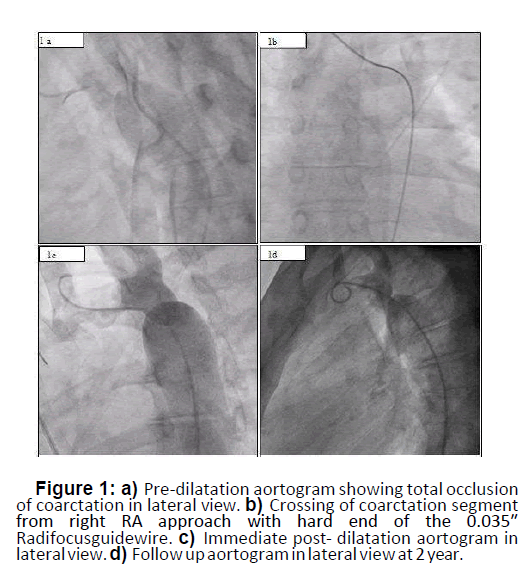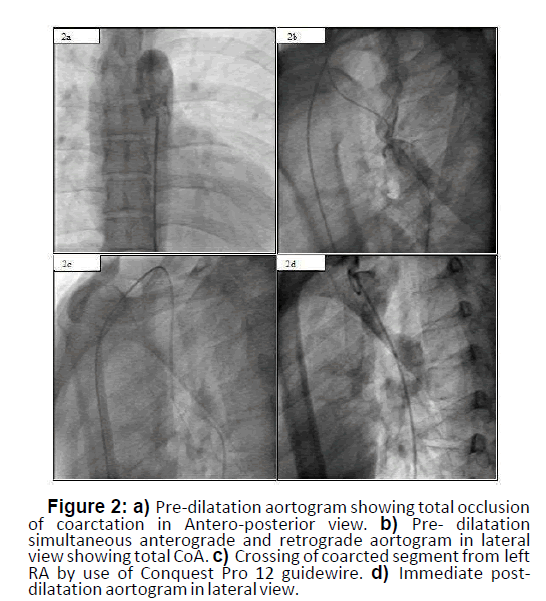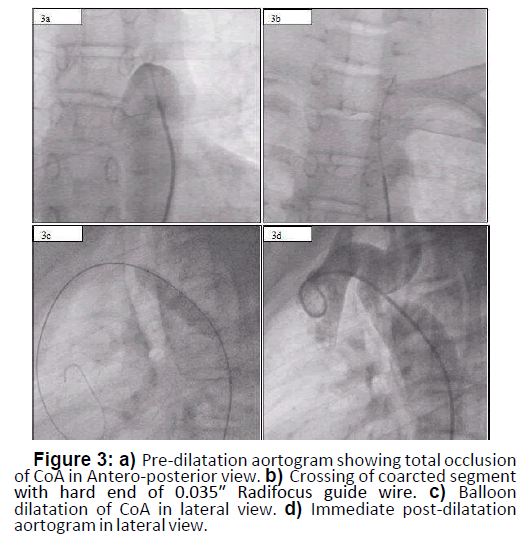Keyword
Coarctation of aorta; Balloon angioplasty;Chylothorax; Subclavian
Introduction
Coarctation of Aorta (CoA) is the congenital narrowing of the descending aorta, which typically involves the area around the insertion of the ductusarteriosus, just distal to the left subclavian artery. The incidence of CoA is 6-8% of all the congenital heart diseases. In severe cases of CoA there may be a complete loss of luminal continuity between the arch and descending aorta.Because of the close anatomic resemblance, the differential diagnosis of totally occluded CoA from interrupted aortic arch should be made before determining the treatment strategy [1] . CoA patients without correction have reduced life expectancy because of several complications such as hypertension, stroke, aortic dissection, accelerated coronary heart disease and heart failure [2].
Surgical repair is the standard treatment for patients with totally occluded CoA, but there have been reports of treatment with percutaneous intervention.In 1982, the balloon dilatation of CoA was used for the first time.Later in 1991 the first stent implantation was introduced.6 Stenting is presently the preferred method for treatment of CoA in adults if surgery is either declined or the patient is unfit [3]. The clinical presentation and response to treatment of patients with isolated totally occluded CoA is similar to that of the patients with isolated CoA.
Surgery was recommended to all our study patients, but some of them were not fit and the others declined surgery due to the associated risk [4]. Surgery has its own disadvantages like increased risk of bleeding complications, a small risk of recurrent laryngeal nerve injury, phrenic nerve injury, chylothorax, wound infection, post-coarctectomy syndrome, aortic dissection, paraplegia, and paradoxical hypertension.Currently, endovascular procedures have been proposed as an alternative treatment for totally occluded CoA. They are preferred to surgical approach because of their less invasive nature and rapid recovery period with high success rates [5-9]. Techniques used include radiofrequency perforation, coronary chronic total occlusion technique, and perforation using the stiff end of a guidewire.A case using the Brockenbrough needle technique has also been reported.Cowley et al found the same outcome of relief of obstruction and an equivalent need for repeat intervention for both surgery and BA, but the risk of aneurysm formation was higher withBA.
Patients in our study were from the resource-constrained segment of society and had neither medical insurance cover nor medicare cover for stenting. Different coronary hardware was used for some cases to cross the occluded segments and make the procedure successful. BA with graded dilatation may give lasting results with good outcomes in these patients. So, it was decided to perform percutaneous treatment of the near-total or totally occluded CoA with graded dilatation balloon angioplasty [10].
Method
Study population
Between 2014 and 2018, 9 adolescent and adult patients with native total or near-total occlusion of CoA were seen at our institution. The indication for BA included angiographic evidence of significant discrete aortic coarctation with coarctation peak systolic gradient more than 20mmHg at cardiac catheterization along with proximal uncontrolled hypertension and/or heart failure [11]. Those who are having gradient less than 20 mm Hg but with LV dysfunction or significant collaterals were also included. The demographic, clinical, imaging, and catheterization data of these patients was reviewed. All the patients were given antihypertensive treatment with a combination. However, the Blood Pressure (BP) was not controlled with medical management alone [12]. After informed consent and prior discussion with the cardiovascular surgeon, we moved ahead with the balloon angioplasty.
Definition
Diagnosis of CoA was suspected in all patients clinically after upper limb hypertension and weak femoral pulses. Discrete coarctation of the aorta was defined as shelf-like morphology in angiographic images [13-17]. Total CoA was defined when there was no detectable flow across coarctation on both retrograde and antegrade injection of iodinated contrast. Near-total CoA was defined when there was nearly 99% occlusion or faint opacification of the distal aorta through a defect in the antegrade injection of contrast. Successful outcome after BA was defined as a peak systolic gradient of ≤ 20 mmHg in catheter pullback after the final BA without any complication. Aneurysm was defined as an area of dilatation which was 150% of the aortic diameter at the level of the diaphragm or a discrete secular dilatation at the site of CoA that was not present before the intervention. Re-coarctation was defined as residual gradient > 20 mm Hg at rest on follow-up catheterization.
Balloon angioplasty technique
Right Femoral Artery (FA) access, under local anesthesia, was established using anatomical landmarks with appropriately sized sheath in all the patients [18]. After systemic heparinization (60 IU/kg), Multipurpose catheter 5F or 6F was introduced in descending aorta up to the point of occlusion of CoA. The hand injection of contrast showed a blind loop of the aorta in some ofthe patientse (Figure 1).
Figure 1: a) Pre-dilatation aortogram showing total occlusion of coarctation in lateral view. b) Crossing of coarctation segment from right RA approach with hard end of the 0.035″ Radifocusguidewire. c) Immediate post- dilatation aortogram in lateral view. d) Follow up aortogram in lateral view at 2 year.
Initially, in all patients we tried both soft and hard end of 0.035″ straight tip hydrophilic Radifocus (Terumo Corporation, Japan) guidewire to cross the coarcted segment. In two of the patients, with some effort, the coarcted segment was crossed with the soft end of the straight Radifocusguidewire in a retrograde approach. In the remaining patients, the hard end of Radifocusguidewire was tried for some more time with careful maneuver, and it was successful in two of the patients, one with near-total coarctation and the other with total coarctation. For the remaining patients, aorticarch was accessed antero gradely through the right radial artery [19].
(RA) in three patients and left radial artery in two patients with a 4F or 5F right coronary diagnostic catheter (Judkins Right) [20,21]. After making sure that the distal ends of the two catheters were well aligned in two orthogonal views (anteroposterior and lateral) simultaneous arch angiogram and descending aorta angiogram were performed with contrast injection in the anteroposterior and lateral projections. Among three patients with right RA approach, one of the coarcted segments was crossed with the hard end of straight 0.035″ Radifocusguidewire, second with the soft end of straight 0.035″ Radifocusguidewire and the third with GAIA Third coronary angioplasty guidewire (GAIA third, Asahi Intec, Japan). In the remaining two patients, left RA access was taken. The crossing of coarctation was again tried with 0.035″ Radifocus and GAIA Third guidewire but it was unsuccessful, so it was subsequently exchanged with a tapered-tip stiff guidewire i.e. Conquest Pro12 (Conquest Pro, Asahi Intec, Japan) (Figure 2).
Figure 2: a) Pre-dilatation aortogram showing total occlusion of coarctation in Antero-posterior view. b) Pre- dilatation simultaneous anterograde and retrograde aortogram in lateral view showing total CoA. c) Crossing of coarcted segment from left RA by use of Conquest Pro 12 guidewire. d) Immediate postdilatation aortogram in lateral view.
In the three patients in whom coronary wire was used, it was first dilated with a coronary non-compliant balloon, after exchanging the Judkins right coronary diagnostic catheter with a Judkins right 5F coronary guide catheter. Subsequently, the guide catheter was advanced across the lesion over the guide wire and balloon assembly was exchanged with Amplatz super- stiff guidewire (St. Jude Medical Inc., MN, USA). In the case of antegrade crossing, Amplatz super-stiff wire was snared out through the femoral sheath using a goose-neck snare and all subsequent procedures were performed through femoral approach keeping the other end of the wire near the radial sheath. Over these guide wires over-the-wire balloon dilatation catheters (OTW), starting with size 12 mm and then gradually increasing, were advanced across the lesion with the final balloon size 1 to 2 mm less or equal to the size of the aorta at diaphragm depending upon the result and residual gradient. The balloon was inflated till the waist had easily disappeared without exerting excess force. After balloon dilatation, the pressure gradient was measured with over the wire pull back multitrack catheter or 5F Judkins right coronary guide without losing the guidewire access in case of requirement for further dilatation. A check angiogram was taken with a pigtail catheter in the end for evaluation of the final result. In the end, angiography showed almost complete establishment of a lumen in the coarcted segment of the aorta. All the patients were discharged after a 48 hour observation period.
Follow-up evaluation
The follow-up was done in the cardiology clinic after 1 month, 3 months, and thereafter 6 monthly. Their follow-up was accomplished by assessment of peripheral pulse, BP measurement in both arms and legs and echocardiography. Those who had Doppler peak gradient of > 20 mmHg after 6 months of the index procedure, underwent repeat catheterization and aortography with pressure measurement across the coarctation segment and if necessary, repeat dilatation (Figure 3).
Figure 3: a) Pre-dilatation aortogram showing total occlusion of CoA in Antero-posterior view. b) Crossing of coarcted segment with hard end of 0.035″ Radifocus guide wire. c) Balloon dilatation of CoA in lateral view. d) Immediate post-dilatation aortogram in lateral view.
Results
Study subjects
A total of nine adolescent and adult patients (3 females) underwent BA for native discrete near-total or total occlusion of CoA during this 5-year period. Their age ranged from 14 to 52 (Mean age 27.88) years. Two of the patients had a bicuspid aortic valve without significant gradient or regurgitation across the valves. All the patients were hypertensive (Systolic BP 150-198 mmHg). The mean systolic blood pressure gradient in the upper limb and the lower limb was 68 mmHg. The mean of peak doppler gradient across coarctation was 68.88 mmHg (range 32-88 mmHg).
Immediate results
The mean peak systolic catheter gradient across coarctation was 79.11 mmHg (range 59 to 98 mmHg) which decreased to 16.67 mmHg (range 12-22 mmHg) after BA. Doppler peak gradient was reduced from 68.88 to 20 mmHg. There were no immediate deaths, dissection of the aorta, or thrombosis of the femoral artery.
Intermediate follow-up
Follow up was ranged from 14 to 72 months (mean 43 months). The peak Doppler gradient across the coarctation site decreased from 58 mmHg before angioplasty to 20.00 mmHg after angioplasty. Follow-up catheterization and angiography were performed in five patients who had peak Doppler gradient of >20 mmHg across coarctation. All the 5 patients had < 20 mmHg peak systolic gradient across coarctation in the catheterization laboratory. There was no re- coarctation and aneurysm formation. The BP was normal ( < 140/90 mm Hg) without medication in 4 patients. The remaining 5 patients were on regular antihypertensive treatment in reduced doses than before the intervention (Table 1).
| Serial no. |
Follow up duration (months) |
Blood pressure in Upper limb (mmHg) |
Doppler gradient on last follow- up (mmHg) |
Peak systolic gradient on Catheter ization (mmHg) |
Complic ations on follow up |
| 1 |
72 |
130/76 |
24 |
4 |
No |
| 2 |
68 |
138/94 |
26 |
6 |
No |
| 3 |
64 |
142/96 |
12 |
- |
- |
| 4 |
48 |
136/78 |
22 |
16 |
No |
| 5 |
44 |
122/88 |
14 |
- |
- |
| 6 |
36 |
150/88 |
28 |
18 |
No |
| 7 |
22 |
138/78 |
30 |
14 |
No |
| 8 |
20 |
132/86 |
12 |
- |
- |
| 9 |
14 |
118/72 |
14 |
- |
- |
Table1:Followupclinicalandimagingdataofstudypatients.
Discussion
This study has demonstrated excellent intermediate-term results of BA of discrete near-total and total occlusion of native aortic coarctation, and we propose that it can be used as one of the initial options for the treatment of discrete coarctation in patients with resource constraint situation. Pressure gradient drops across the coarctation segment were immediately significant in all cases and proved durable in all the cases of coarctation. Persistent hypertension was improved or even completely relieved in the majority of patients.
The balloon dilatation method can result in serious complications such as the formation of an aneurysm, aortic dissection, or aortic rupture. Previously, investigators had demonstrated that the outcome with BA was not significantly different from stent implantation.Various studies have shown that stent implantation is associated with lower complication rates when compared to balloon angioplasty alone and surgery. But in our study, all the patientswere from resource-constrained situations and without any medical insurance facility for the treatment. As stenting is associated with prohibitive costs, we went ahead with only BA after discussion with patients or relatives and after having discussed with the cardiac surgery team for necessary back-up, if required.
The presence of cystic medial necrosis was the proposed mechanism for the development of aneurysm that may provide a pathologic basis for the development of aneurysms associated with native coarctation, after BA and stent implantation. Although in our study no one developed aneurysm, early studies have reported a high incidence of aneurysm formation after BA; with the incidence varying between 1.8% and 15%.18,19 Oversized balloon and use of very high pressure for dilatation might be the possible causes which were deliberately avoided. Close follow-up is required for patients with or without aneurysm, and MRI is a valuable noninvasive imaging modality for patients who have undergone coarctation angioplasty withoutstenting.
Blood pressure was reverted to normal without medication in 45% (4/9) of patients. (30%), we encountered a higher number of patients requiring medication i.e. 55% (5/9) to control hypertension after angioplasty. Hypertension in the absence of residual coarctation appears to be related to the duration of preangioplasty hypertension and insufficient resetting of the baroreceptors after BA.However, all patients treated with BA should be monitored closely for recurrence of hypertension for longer follow- up periods. In our study, on a mean follow up of 3.5 years no patient developed re- coarctation. Previous studies have reported the re-coarctation rate varying from 0% to 9% in adults.
Our case series has two unique features. The first is the use of BA only for the treatment of near-total or totally occluded aortic coarctation. The second is the utilization of the techniques used in the standard treatment of the coronary artery Chronic Total Occlusions (CTO) angioplasty. Our approach was successful in the treatment of total occluded CoA using the coronary CTO technique for recanalization. The present case series suggests that BA alone can also be efficient in the treatment of near-total or total occlusion of CoA.
Conclusion
This study demonstrated safety and efficacy of BA for native discrete near-total and total occlusion of CoA at intermediateterm (average 3.5 years) follow-up in adolescent and adult patients. Accordingly, we recommend that BA can be considered as an alternative option for the treatment of discrete near-total and totally occluded CoA in adolescent and adult patients in a resource-constrained situation or if surgery is notpossible.
References
- Jie H, Kaplan S (2002) The incidence of congenital heart disease. J Am CollCardiol 39: 1890-1900.
- Kaneda T, Miyake S, Kudo T (2003) Obstructed coarctation in a right aortic arch in an adult female. ThoracCardiovascSurg51: 350–352.
- Vriend JW, Lam J, Mulder BJ (2004) Complete aortic arch obstruction: interruption or aortic coarctationt?.JInCardiovasc Imaging 20:393–396.
- Yazici HU, Ulus T, Temel K (2012) Percutaneous treatment of totally occluded the coarctation of the aorta with angioplasty and stenting. Eur Rev Med PharmacolSci 16: 96–99.
- Singer MI, Rowen M, Dorsey TJ (1982) Transluminal aortic balloon angioplasty for coarctationtohfe aorta in the newborn. Am Heart J 103: 131-132.
- Laughlin MP, Perry SB, Lock JE, Mullins CE (1991) Use of endovascular stents in congenital heart disease. Circulation 83: 1923-1939.
- Holzer R, Qureshi S, Ghasemi A (2010) Stenting of the coarctation of the aorta: acute, intermediate, and long-term results of a prospective multi- institutional registry Congenital Cardiovascular Interventional Study Consortium (CCISC). Catheter CardiovascInterv 76:553-563.
- Joseph G, Mandalay A, Rajendiran G, (2001) Percutaneous recanalization and balloon angioplasty of congenital isolated local atresia of the aortic isthmus in adults. Catheter CardiovascInterv 53: 535-41.
- Bozzani A, Arici V, Ragni F (2013) Thoracic aorta coarctation in the adults: opensurgery is still thegoldstandard. VascEndovascular Surg 47: 216– 218.
- Anagnaostopoulos TA (2007) Management of aortic coarctation in adults: endovascular versus surgical therapy. Hellenic J Cardiol 48: 290– 295.
- Goel PK, Syal SK (2008) Percutaneous reconstruction of aortic isthmus atresia using coronary total occlusion technique. J Cardiol Cases 10:121-125.
- Lenk K, Dähnert I, Schuler G (2008) Complete occlusion of the aortic isthmus. Eur Heat J 2: 29-30.
- Cowley CG, Orsmond GS, Feola P (2005) Long-term, randomized comparison of balloon angioplasty and surgery for native coarctationoftheaortainchildhood.Circulation111:3453-6.
- Beekman RH, Rocchini AP, Dick M (1987) Percutaneous balloon angioplasty for native coarctation of the aorta. J Am CollCardiol 10: 1078-84.
- Zabal C, Attie F, Rosas M (2003) The adult patient with native coarctation of the aorta balloon angioplasty or primary stenting. Heart 89:77-83.
- Chessa M, Carrozza M, Butera G (2005) Results and mid-long-term follow- up of stent implantation for native and recurrent coarctation ofthe aorta. Eur Heart J 26: 2728-2732.
- Mendelsohn AM, Lloyd TR, Crowley DC (1994) Late follow-up of balloon angioplasty in children with a native coarctation of the aorta. Am J Cardiol 74: 696-700.
- Fawzy ME, Sivanandam V, Galal O (1997) One to ten-year follow- up results of balloon angioplasty of native coarctation of the aorta in adolescentsandadults. J Am CollCardiol 30:1542-6.
- Walhout RJ, Lekkerker JE, Ernst SP (2002) Angioplasty for coarctation in different aged patients. Am Heart J 144: 180-6.
- Fletcher SE, Nihill MR, Grifka RG (1995) Balloon angioplasty of native coarctationtohfe aorta: midterm follow-up and prognostic factors. J Am CollCardiol 25: 730-4.
- Giavanni JV, Lip GYH, Osman K (1996) Percutaneous balloon dilatation of aortic coarctation in adults. Am J Cardiol 77: 455-9.




